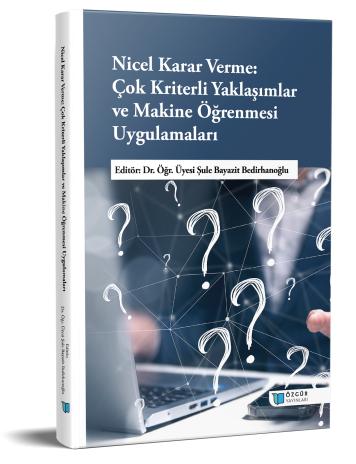
Multi-Criteria Decision Making and Machine Learning: Integration and Applications
Chapter from the book:
Bayazit Bedirhanoğlu,
Ş.
(ed.)
2025.
Quantitative Decision Making: Multi-Criteria Approaches and Machine Learning Applications.
Synopsis
In today's world, decision-making processes have become increasingly complex due to the presence of numerous alternatives and conflicting criteria. Multi-Criteria Decision-Making (MCDM) methods provide systematic and mathematical approaches to address such problems. However, the growing volume and complexity of data are pushing the limits of traditional MCDM techniques. Machine Learning (ML), with its ability to learn from data, offers significant advantages in decision support systems. Among the various ML paradigms—supervised, unsupervised, and reinforcement learning—hybrid approaches have been developed in conjunction with MCDM methods for tasks such as criteria weighting, alternative classification, and dynamic decision modeling. This integration enhances the explainability of decision processes and enables data-driven, adaptive decision mechanisms. Moreover, model explainability and ethical decision-making have become central themes in contemporary research.This study aims to provide both a theoretical and practical framework for integrating MCDM and ML methods, thereby offering more flexible, data-centric, and interpretable solutions to complex decision problems. While traditional MCDM methods are powerful tools for structuring well-defined decision processes, they often fall short in dynamic, large-scale, and uncertain data environments. ML algorithms can learn decision functions from historical data, automatically derive criteria weights, and classify alternatives. In this context, supervised, unsupervised, and reinforcement learning contribute uniquely to various stages of the decision-making process.As a practical example, the use of the Random Forest classifier along with SMOTE in supplier selection demonstrates that minority classes can be accurately predicted, resulting in a 15% improvement in model accuracy. Additionally, Explainable Artificial Intelligence (XAI) techniques are emphasized for their role in developing transparent and ethically sound decision systems. In conclusion, the integration of MCDM and ML holds substantial potential for making decision support systems more reliable, agile, and user-friendly, while also highlighting the need for further research in areas such as explainability, ethics, and regulatory compliance.

